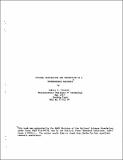| dc.description.abstract | Earlier studies of exhaustible resource production and pricing usually assume that there is a fixed reserve base that can be exploited over time. In reality there is no "fixed" reserve base (in an economically meaningful sense), since as price rises, additional proved and potential reserves become economical. Here we view a resource like oil as being "nonrenewable" rather than "exhaustible."
There is a proved reserve base which is the basis for production, and exploratory
activity is the means of increasing or maintaining this proved reserve base.
"Potential reserves" are unlimited, but as depletion ensues, given amounts of exploratory activity result in ever-smaller discoveries. Thus resource producers must determine simultaneously their optimal rate of exploratory activity and their optimal rate of production. Optimal trajectories for exploratory activity and production are determined for both competitive and monopolistic producers, and are applied to a simple model of oil production in the Permian region of Texas.
This report was partly sponsored by the Electric Power Research Institute, Inc.
(EPRI). Neither EPRI, members of EPRI, nor the Massachusetts Institute of Tecnnology,
nor any person acting on behalf of either;
a. Makes any warranty or representation, express or implied, with respect to the accuracy, completeness, or usefulness of the information contained in this report, or that the use of any information, apparatus, method, or process disclosed in this report may not infringe privately owned rights; or
b. Assumes any liabilities with respect to the use of, or for damages resulting from the use of, any information, apparatus, method, or process disclosed in this report. | en |
